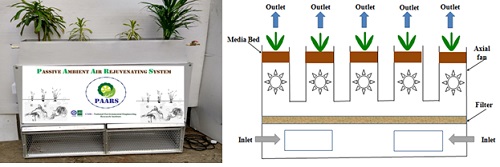The Ministry of Science and Technology (MoS&T) in collaboration with several other Ministries and Departments has accelerated efforts towards energy efficiency, energy conservation and generation of alternative energy.
Participating in inter-ministerial programs like Solar Mission, Clean Energy Mission among others and international collaborations like Mission Innovation, International Solar Alliance, the Ministry has boosted research and development on energy efficiency in multiple sectors, energy conservation methods and alternative energies and developed several technologies catering to these.
The Department of Science and Technology (DST) has developed various technologies like Micro Solar Dome that captures day light and concentrate it inside a dark room, Hybrid Solar-Biomass Power Plant and Solar Inverter, Solar sea water desalination and thermal storage units, Shallow emitter silicon solar cell, focused on development of renewable energy in India and also drive mass awareness about the energy efficiency and conservation.
Surya Jyoti: Captures day light & concentrate it inside a dark roomSurya Jyoti is a unique device which captures day light and concentrate the same inside a dark room, particularly in urban slum or rural areas which lack electricity supply.

- Suitable for any type of roof: Asbestos, Galvanized corrugated iron Sheet, Mud tiles or concrete
- Safe, hygienic lighting solution for urban & rural poor providing 16 hr continuous light
- Low cost, zero CO2 emission lighting device with long life
- Easy to fabricate, fix and maintain and can generate employment
- Solar PV - 2 X 3 watt crystalline Solar Panel suitable for charging of 7.5 Ah, 4-volt Lithium Ion battery with 3 X 1 watt LEDs mounted on the Lower part of sun tube.
High Efficiency Silicon Solar Cell
Lightly doped emitter developed by optimizing various process steps using new front metal contact pastes & shallow emitter adopting standard manufacturing steps without any additional process steps.
Best cell efficiency of 19.24% was achieved with typical efficiency distribution of 19% for a few batches of solar cells.
![]()
- Shallow emitter and modules process technology
- Solar cell efficiency achieved commercially at the commencement of project by BHEL was 17%. That was raised to 18.75% in commercial manufacturing facility of Electronic Division (EDN), BHEL at Bangalore.
Hybrid Solar-Biomass Power Plant
Renewable energy based small scale distributed energy plants integrating solar & biomass for a 24x7 operation with a capability to dispatch power into the local grid for export of power. The pilot scale facility was developed at 200 kW which can be scaled-up to 3 MW.

- Solar Parabolic Trough technology operating, direct Steam Generation, Organic Rankine Cycle and is now evacuating power to existing Grid at Shive Village
- Integrates biomass & solar for 24x7 operation
- Dispatches power to local grid
- Pilot scale facility developed at 200 KW
Energy saving water filter: JalKalp

- Does not require any energy, works under gravity
- Filter 0.6 litres per minute removing turbidity, iron arsenic and biological impurities such as bacteria, protozoa, viruses, and parasites, etc.
- Easy, inexpensive, sustainable and effective technique to treat water.
- Easy to operate and maintain with no periodic maintenance cost.
Passive Ambient Air Purifier System (PAARS)

The device basically works on the principle of passive removal of pollutants and wind generation for dilution of air pollutant.
- Air is passed through appropriate size filters where particulates are removed.
- Air free of particulates is then passed through media with plant which further helps in reducing gaseous pollutants in the air.
- Air generators can help in augmenting wind turbulence in near zone so that dilution takes place.
- At the outlet of the device, the air has some residual velocity.
- This velocity of air creates turbulence in the atmosphere which thereby helps bringing down the pollutant concentrations by the method of dispersion.
Air Purification using solar power: WAYU

National Environmental Engineering Research Institute (NEERI), IIT Bombay, and Maharashtra Pollution Control Board (MPCB) have come together to develop a technology to reduce air pollution at traffic junctions using solar power.
This device works basically on two principles: Wind generation for dilution of air pollutants & Active Pollutants removal.
- Uses solar as power source in air generators
- Removes pollutants like carbon monoxide, hydrocarbons, VOS by converting them to carbon dioxide
- Other pollutants removed through dispersion
The device uses low speed wind generators, appropriate size filters for long operation cycle with reasonable efficiency. It also has an oxidizer unit for removal of Carbon-monoxide and Hydrocarbons including VOCs. The air is passed through the filters where the particulates are removed. The air generators without filter can help in augmenting wind turbulence in near zone so that dilution takes place (like in nature).
The air is heated inside the specially designed with appropriate surface and retention time, within the thermal oxidisers where the carbon monoxide, hydrocarbons, VOCs get converted to carbon dioxide. At the outlet of the device, the discharged air has some exit velocity. This velocity of air creates air mixing and turbulence in the atmosphere which thereby helps bringing down the pollutant concentrations by the method of dispersion.
Participation in Mission innovation
MoS&T committed to double Government funded clean energy research and development over 5 years as part of this multi-country initiative designed to accelerate the pace of innovation and make clean energy widely affordable,
This is enhancing international engagement in programmes on clean energy R&D and setting up demand oriented mission programmes on clean coal technologies, building energy efficiency, cleaner fuels besides consolidating and orienting present research in solar energy to national needs.
DST is coordinating two innovation challenges of Mission Innovation: Smart Grids Innovation Challenge & Off-Grid Access to Electricity Innovation Challenge – for reducing energy consumption through using less of energy.






























